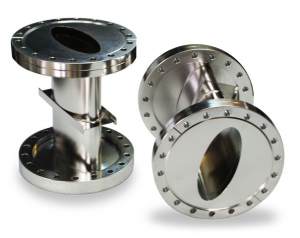Call: 708-425-9080
Reducing Hydrogen Outgassing in Stainless Steel Vacuum Vessels

Recently we received a request for quote to fabricate several stainless steel vacuum chambers that were to be processed to reduce hydrogen outgassing. The prescription for the outgassing reduction process was light on detail and differed a bit from similar requirements we have seen previously. The drawing notes simply stated “Electropolish. Vacuum fire at 850C.” Requirements for reduction of hydrogen outgassing we had seen in the past had taken one of two approaches:
1. A vacuum bake out around 400C for a period of time, normally at least 72 hours.
Less common but sometimes seen,
2. A full vacuum anneal, prescribing temperature ramp up, hold times and rapid quench.
The following remarks apply to the 300 Series austenitic stainless steels, 304L and 316L being the grades commonly used in fabrication of vacuum vessels.
I admit that we had followed customer requirements in the past, concentrating on the process and not researching the reasons behind the bake out prescriptions; however, the 850C requirement for this application had us worried. From past experience with thermal stress relief of austenitic stainless steel, we were aware that the temperature range, 600C to 900C, was a critical one for this type of stainless steel. In this temperature range chromium carbides could precipitate in the grain boundaries, which could detrimentally affect the corrosion resistance of the metal. As low carbon austenitic stainless steel would be processed this was less of a risk, but still seemed an unnecessary one.
Reviewing an iconic source, O’Hanlon “A User’s Guide to Vacuum Technology,” I was surprised to discover in Table 16.3 Outgassing Rates of 316L Stainless Steel After Different Processing Conditions, outgassing rates for a surface treatment listed as “Degassing at 800C for 2h in a vacuum furnace.” The source of this table was a 1977 article in the Journal of Vacuum Science and Technology. This article “Technology of low-pressure systems - establishment of optimum conditions to obtain low degassing rates on 316 L stainless steel by heat treatments” by J. Nuvolone was available on the AIP website.
The Nuvolone article detailed the results of a series of degassing experiments performed on identical 316LSS vacuum chambers. The chambers underwent the 8 different degassing processes. The tabulated results from these experiments are quoted in Table 16.3 of O’Hanlon. The paper presented the data without specifying any underlying theory. The author concluded that a process that combined predegassing of stainless steel components in a high vacuum (10-9 torr) furnace followed by a process at lower temperatures to form an oxide layer on the components results in the lowest outgassing rates for not just hydrogen but other gas molecules as well.
In the course of locating the Nuvolone article I came across a very useful article on the IEEE website, Y.T. Sasaki, Reducing SS 304/316 Hydrogen Outgassing to 2x10-15 torr-l/s. This article describes a hydrogen degassing prescription and the reasoning behind that procedure. This technique was developed to reduce hydrogen outgassing to ultralow levels for stainless steel vessels used in the handling and storage of hydrogen isotopes. The process involves electropolishing followed by vacuum firing.
In this process called “Quantum Passivation” by the author the stainless steel is first electropolished to 0.05 micrometers Ra (~2.2 RMS), essentially a mirror finish. This electropolishing step results in two desirable outcomes, it reduces the surface constituent of nickel, iron and manganese on the stainless steel causing a chromium rich surface and it reduces the surface roughness of the stainless steel. Removing surface nickel and iron reduces hydrogen adsorption due to the nickel and reduces the number of catalytic actions due to the ferrite. The chromium enriched surface forms a chromium oxide layer further blocking hydrogen adsorption.
The vacuum firing step is used to remove interstitial hydrogen. The author states a 400C bake out under high vacuum (1x10-6 torr) is sufficient. The prescription calls for increasing the heat while maintaining the vacuum level in the vacuum furnace no higher than 1x10-6 torr until reaching 400C. The vessel is then baked at 400C until in this process the furnace stabilizes in the low 10-8 torr range. Confirming statements in other papers scanned during this literature search, the author also states that while higher temperatures can reduce bake out time little is gained above temperatures of 530C.
From a practical standpoint electropolishing to a mirror finish is more costly than the standard UHV practice of <16RMS and most commercial vacuum furnaces capable of processing largish vacuum vessels aren’t capable of vacuum levels below 10-6 torr. Still, based on the theory behind the prescription, it seems safe to conclude that for most applications a process involving electropolishing followed by a vacuum firing at 400C until a stable 10-6 torr is maintained would produce a stainless steel vessel with a very low hydrogen outgassing rate.
Determining the best processes to accomplish our customers’ technical requirements is part of Meyer Tool’s commitment to providing the lowest total cost of ownership. When we learn something new while defining that process, it is just part of the fun.
1. A vacuum bake out around 400C for a period of time, normally at least 72 hours.
Less common but sometimes seen,
2. A full vacuum anneal, prescribing temperature ramp up, hold times and rapid quench.
The following remarks apply to the 300 Series austenitic stainless steels, 304L and 316L being the grades commonly used in fabrication of vacuum vessels.
I admit that we had followed customer requirements in the past, concentrating on the process and not researching the reasons behind the bake out prescriptions; however, the 850C requirement for this application had us worried. From past experience with thermal stress relief of austenitic stainless steel, we were aware that the temperature range, 600C to 900C, was a critical one for this type of stainless steel. In this temperature range chromium carbides could precipitate in the grain boundaries, which could detrimentally affect the corrosion resistance of the metal. As low carbon austenitic stainless steel would be processed this was less of a risk, but still seemed an unnecessary one.
Reviewing an iconic source, O’Hanlon “A User’s Guide to Vacuum Technology,” I was surprised to discover in Table 16.3 Outgassing Rates of 316L Stainless Steel After Different Processing Conditions, outgassing rates for a surface treatment listed as “Degassing at 800C for 2h in a vacuum furnace.” The source of this table was a 1977 article in the Journal of Vacuum Science and Technology. This article “Technology of low-pressure systems - establishment of optimum conditions to obtain low degassing rates on 316 L stainless steel by heat treatments” by J. Nuvolone was available on the AIP website.
The Nuvolone article detailed the results of a series of degassing experiments performed on identical 316LSS vacuum chambers. The chambers underwent the 8 different degassing processes. The tabulated results from these experiments are quoted in Table 16.3 of O’Hanlon. The paper presented the data without specifying any underlying theory. The author concluded that a process that combined predegassing of stainless steel components in a high vacuum (10-9 torr) furnace followed by a process at lower temperatures to form an oxide layer on the components results in the lowest outgassing rates for not just hydrogen but other gas molecules as well.
In the course of locating the Nuvolone article I came across a very useful article on the IEEE website, Y.T. Sasaki, Reducing SS 304/316 Hydrogen Outgassing to 2x10-15 torr-l/s. This article describes a hydrogen degassing prescription and the reasoning behind that procedure. This technique was developed to reduce hydrogen outgassing to ultralow levels for stainless steel vessels used in the handling and storage of hydrogen isotopes. The process involves electropolishing followed by vacuum firing.
In this process called “Quantum Passivation” by the author the stainless steel is first electropolished to 0.05 micrometers Ra (~2.2 RMS), essentially a mirror finish. This electropolishing step results in two desirable outcomes, it reduces the surface constituent of nickel, iron and manganese on the stainless steel causing a chromium rich surface and it reduces the surface roughness of the stainless steel. Removing surface nickel and iron reduces hydrogen adsorption due to the nickel and reduces the number of catalytic actions due to the ferrite. The chromium enriched surface forms a chromium oxide layer further blocking hydrogen adsorption.
The vacuum firing step is used to remove interstitial hydrogen. The author states a 400C bake out under high vacuum (1x10-6 torr) is sufficient. The prescription calls for increasing the heat while maintaining the vacuum level in the vacuum furnace no higher than 1x10-6 torr until reaching 400C. The vessel is then baked at 400C until in this process the furnace stabilizes in the low 10-8 torr range. Confirming statements in other papers scanned during this literature search, the author also states that while higher temperatures can reduce bake out time little is gained above temperatures of 530C.
From a practical standpoint electropolishing to a mirror finish is more costly than the standard UHV practice of <16RMS and most commercial vacuum furnaces capable of processing largish vacuum vessels aren’t capable of vacuum levels below 10-6 torr. Still, based on the theory behind the prescription, it seems safe to conclude that for most applications a process involving electropolishing followed by a vacuum firing at 400C until a stable 10-6 torr is maintained would produce a stainless steel vessel with a very low hydrogen outgassing rate.
Determining the best processes to accomplish our customers’ technical requirements is part of Meyer Tool’s commitment to providing the lowest total cost of ownership. When we learn something new while defining that process, it is just part of the fun.



